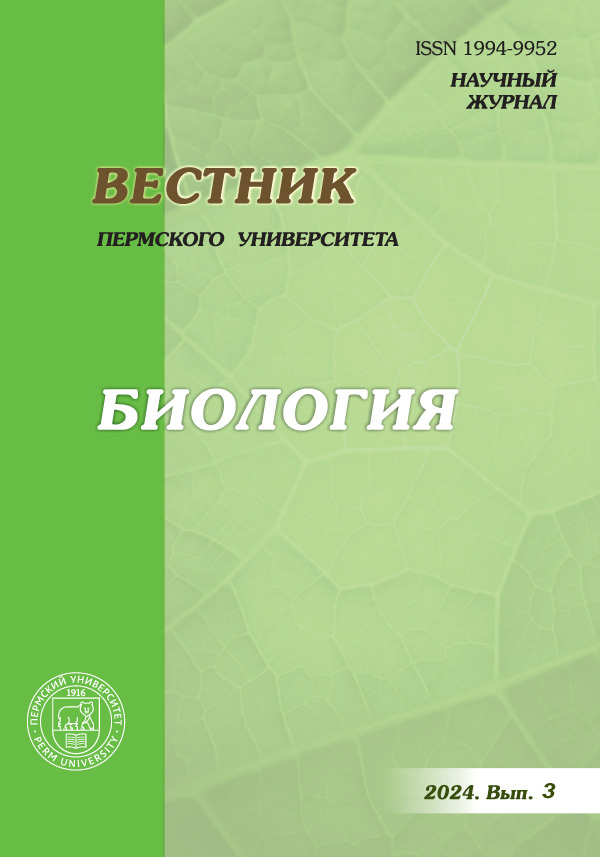Isolation and сharacterization of dibutyl phthalate-degrading strain Rhodococcus sp. 5A-K4
Main Article Content
Abstract
Article Details
References
Бачурин Б.А., Одинцова Т.А. Стойкие органические загрязнители в отходах горного производства // Современные экологические проблемы Севера. Апатиты: Изд-во Кольского НЦ РАН, 2006. Ч. 2. С. 7–9.
Нетрусов А.И. Практикум по микробиологии. М.: Академия, 2005. 608 с.
Чернявская М.И. и др. Первичный анализ генома бактерий-деструкторов нефти Rhodococcus pyridinivorans 5Ap // Труды БГУ. 2016. Т. 11, ч. 1. С. 219–223.
Aleshchenkova Z.M. et al. The degradation of plasticizers by Rhodococcus erythropolis 40F // Mikrobiol. Z. 1996. Vol. 58(4). P. 34–38.
Ausbel F.M. Short Protocols in Molecular Biology. 3rd ed. N.Y.: John Wiley & Sons, 1995. 450 p.
Chao W.L., Cheng C.-Y. Effect of introduced phthalate-degrading bacteria on the diversity of indigenous bacterial communities during di-(2-ethylhexyl) phthalate (DEHP) degradation in a soil microcosm // Chemo-sphere. 2007. Vol. 67(3). P. 482–488.
Chao W.L. et al. Degradation of di-butyl-phthalate by soil bacteria // Chemosphere. 2006. Vol. 63(8). P. 1377–1383.
Gao D.-W., Wen Z.-D. Phthalate esters in the environment: a critical review of their occurrence, biodegra-dation, and removal during wastewater treatment processes // Science of the Total Environment. 2016. Vol. 541. P. 986–1001.
Gardner S.T. et al. Assessing differences in toxicity and teratogenicity of three phthalates, diethyl phthalate, di-n-propyl phthalate, and di-n-butyl phthalate, using Xenopus laevis embryos // Journal of Toxicol-ogy and Environmental Health. 2016. Vol. 79(2). P. 71–82.
He Z., Niu C., Lu Z. Individual or synchronous biodegradation of di-n-butyl phthalate and phenol by Rhodococcus ruber strain DP-2 // Journal of Hazardous Materials. 2014. Vol. 273. P. 104–109.
Jin D.-C. et al. Biodegradation of di-n-butyl phthalate by Rhodococcus sp. JDC-11 and molecular detec-tion of 3,4-phthalate dioxygenase gene // Journal of Microbiology and Biotechnology. 2010. Vol. 20(10) P. 1440–1445.
Lane D.J. 16S/23S rRNA sequencing // Nucleic acid techniques in bacterial systematics. 1991. P. 115–175.
Li J. et al. Bioremediation of environmental endocrine disruptor di-n-butyl phthalate ester by Rhodococ-cus ruber // Chemosphere. 2006. Vol. 65(9). P. 1627–1633
Li K., Gu J. Biodegradation of di-n-butyl phthalate by mangrove microorganism Rhodococcus ruber 1K // Ying Yong Sheng Tai Xue Bao. 2005. Vol. 16(8). P. 1566–1574.
Liu T. et al. Synthetic bacterial consortia enhanced the degradation of mixed priority phthalate ester pol-lutants // Environmental Research. 2023. Vol. 235. P. 116–121.
Lu M. et al. Degradation of dibutyl phthalate (DBP) by a bacterial consortium and characterization of two novel esterases capable of hydrolyzing PAEs sequentially // Ecotoxicology and Environmental Safety. 2020. Vol. 195. P. 1–9.
Lu Y. et al. Biodegradation of dimethyl phthalate, diethyl phthalate and di-n-butyl phthalate by Rhodo-coccus sp. L4 isolated from activated sludge // Journal of Hazardous Materials. 2009. Vol. 168(2-3). P. 938–943.
Mahajan R. et al. Biodegradation of di-n-butyl phthalate by psychrotolerant Sphingobium yanoikuyae strain P4 and protein structural analysis of carboxylesterase involved in the pathway // International Journal of Biological Macromolecules. 2019. Vol. 122. P. 806–816.
Nazarov A.V. et al. Soil bacterial communities in the affected zone of salt dump (Solikamsk, Perm krai) // Eurasian Soil Science, 2024, Vol. 57(8). P. 1353–1361.
Raymond R.L. Microbial oxidation of n-paraffinic hydrocarbons // Developments in Industrial Microbi-ology. 1961. Vol. 2(1). P. 23–32.
Song X. et al. Biodegradation of phthalate acid esters by a versatile PAE-degrading strain Rhodococcus sp. LW-XY12 and associated genomic analysis // International Biodeterioration and Biodegradation. 2022. Vol. 170. P. 1–12.
Vamsee-Krishna C., Phale P.S. Bacterial degradation of phthalate isomers and their esters // Indian Jour-nal of Microbiology. 2008. Vol. 48. P. 19–34.
Wang L. et al. Analysis of the performance of the efficient di-(2-ethylhexyl) phthalate-degrading bacte-rium Rhodococcus pyridinovorans DNHP-S2 and associated catabolic pathways // Chemosphere. 2022. Vol. 306. P. 135–142.
Yang T. et al. Biodegradation of di-(2-ethylhexyl) phthalate by Rhodococcus ruber YC-YT1 in contami-nated water and soil // International Journal of Environmental Research and Public Health. 2018. Vol. 15(5). P. 1–20.
